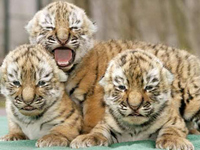

 |

|
 Siberian Tiger |
Siberian Tiger(Mammal) |
 Siberian Tiger Baby |
Siberian Tiger HabitsThe Siberian tiger occupies a very large territory. Ranges of more than 4,000 square miles have been recorded. The tiger may occupy the same territory for many years if food sources are stable within the area. If prey is scarce, it often migrates hundred of miles.
Both males and females mark the boundaries of their ranges with urine and by scratching trees. But only the male defends his territory against other males, concentrating on the most important parts, such as a boundary close to a female's territory or an area rich in food.
The male tiger is solitary, shunning other males. He allows tigers of either sex to pass through his range but is more tolerant of females. The female is sometimes accompanied by her young.
The Siberian tiger's winter coat lacks the red stripes of tigers from warmer climates, but its white coat helps camouflage it in its snowy habitat.
Because it has to withstand temperatures as low as 50** F, the Siberian tiger grows a longer and thicker coat than other tigers. It also develops a layer of fat on its flanks and belly that helps to insulate it. |
Siberian Tiger CommunicationIn captivity, tigers make a noise called a chuff as a greeting when they are happy. This is a gentile puffing sound tigers make by rapidly expelling air through their noses. In the wild, they make this noise while communicating with other tigers, especially their mothers and siblings.
Roaring is another integral method of communication. A roar from a tiger acts as a warning to other tigers, animals and humans to keep their distance. Sometimes a roar can be used to bring another tiger closer, as roars are utilized also for long range communication. A roar can be heard up to two miles away.
Other forms of snarls and growls act as warnings as well. Mothers will often softly moan to their cubs to call them. Also, "prusten" is a specific, low intensity call used by mothers to interact with their cubs, or between tigers during courtship. |
Siberian Tiger BreedingTigers mate at any time during the year. A female shows that she is ready to mate by leaving urine deposits and scratch marks on trees. In Siberia, where a tiger's range is vast, she may go in search of a male.
The female is receptive for only three to seven days. during this time a pair will mate many times, after which the male leaves to mate with another female.
After a gestation period of three to three and a half months, three or four blind cubs are vorn is a sheltered den. they are nursed by their mother, who rarely leaves them. At about two weeks old their eyes open and their first teeth begin to grow
At three months the cubs start to leave the den, and the mother brings them meat to eat. They continue to take her milk until they are five or six months old. At this stage they may begin to accompany her on hunting trips.
The cubs are less than a year old when they start to hunt for themselves. At two years old they can kill large prey, but they will not leave their mother until they are three to five years old. They then start to look for their own territories and mates. |
Siberian Tiger Food & FeedingThe Siberian tiger spends a lot of time hunting because only about one in ten of its hunting trips is successful. It preys mainly on deer and wild pig, but it also eats fish.
Creeping to within 30 to 80 feet of its victim, the tiger pounces and grabs the prey by the nape of the neck with its back feet still planted firmly on the ground.
This name bite kills small prey, but larger prey is brought to the ground before being killed by a suffocating bite to the throat. If the tiger misses its prey on the pounce, it may chase if for up to 650 feet but rarely catches it.
When it does kill its prey, the tiger drags it to cover, usually near water. It then eats its fill, covers up the remains, and goes to sleep. Later it eats the rest of the carcass. |
Siberian Tiger Key Facts |
| Size |
| Height: About 3 1/2 feet at shoulder. Length: Male, 9-12 feet head to tip of tail. Female smaller |
| Weight: 400-650 pounds |
| Breeding |
| Sexual maturity: 3-5 years |
| Mating: No particular season |
| Gestation: 3-3 1/2 months |
| Number of young: Up to 6 cubs, but usually 3-4 |
| Lifestyle |
| Habit: Male is solitary. Female lives in family units. Mostly nocturnal |
| Diet: Deer, boar, elk, lynx, bear; also small prey such as fish, rabbits, and hares |
| Lifespan: Up to 25 years |
DID YOU KNOW?
|
CAN'T FIND WHAT YOU'RE LOOKING FOR? CLICK HERE!!!